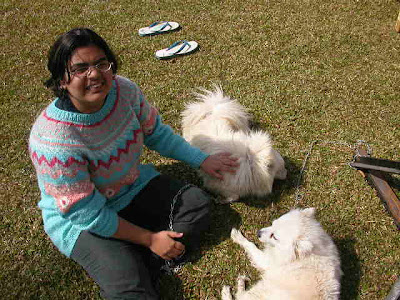
This is my mother, who has been knitting for more than 60 years now. She loves it, and not even the heat of summer can keep her from handling the wool. She only had to hear of another great-grandchild on the way, than she arranged for wool to be sent from Delhi by my sister, and she started on a layette. And here it is.

My mother says that her first piece was for herself. As a new bride from Trivandrum in New Delhi, she was confident that she could face her first winter by knitting something for herself - she had after all learnt to knit in school. She says, “Babuji got me some wool in a budgie yellow shade, a pair of knitting needles, and a pattern in a magazine, and told me to start off. And that was my first knitted product – a blouse.” Though taken aback at first, she took it as a challenge and it turned out very well. The next one was for my father and after that – for me.
 I must have been very young when she knitted sweaters for me first, for I spent my infancy and childhood in Delhi. And we all know what the winters there are like. I still remember the patterns of some of them. (That is me in 1949/50) My mother knitted for all three of us and for my father and herself.
I must have been very young when she knitted sweaters for me first, for I spent my infancy and childhood in Delhi. And we all know what the winters there are like. I still remember the patterns of some of them. (That is me in 1949/50) My mother knitted for all three of us and for my father and herself.After a few years spent in the south (read about it here), where we did not need any woollens at all, we came back to Delhi and then all of us needed sweaters. By then there were five of us. Maiji taught me also to knit, and we built up the basics for each of us. I could only do some plain knitting, but my skills also improved, and I could later on follow patterns from books. But with college and studies I could not do much. The collection of knitwear grew, and there was enough to keep us all warm.
Over the years, my youngest sister was the lucky beneficiary of my mother’s art. My mother made several items for her, so much so that Gowri became known as the daughter of the knitting lady among her friends’ mothers.
 Apart from being a nimble knitter, my mother has evolved from being a pattern follower to a pattern creator – designer, if you will. I have really lost track of the number of sweaters, cardigans, layettes, scarves, shawls, ponchos (most of which are her own patterns) caps and mufflers, and even dresses (that is my niece wearing one of the pieces) she has designed and knitted. Fair Isle and cable patterns became child’s play to her. When I wore the poncho she knitted for me on my visit to my sons, the poncho was the in thing then, and I had inadvertently become ‘in’ too!
Apart from being a nimble knitter, my mother has evolved from being a pattern follower to a pattern creator – designer, if you will. I have really lost track of the number of sweaters, cardigans, layettes, scarves, shawls, ponchos (most of which are her own patterns) caps and mufflers, and even dresses (that is my niece wearing one of the pieces) she has designed and knitted. Fair Isle and cable patterns became child’s play to her. When I wore the poncho she knitted for me on my visit to my sons, the poncho was the in thing then, and I had inadvertently become ‘in’ too!
And here is my niece wearing a fair isle sweater created by Ma

Her creativity extends to an original too – the doll made totally with wool.
 The doll is knitted and her clothes too. Scraps of wool make up the stuffing so that the doll is washable. Without exaggerating, I can say that she must have knitted at least a hundred of these for her grandchildren and great granddaughters, and as gifts to give to other little girls. Here the doll is resting on shawls knitted by my mother.
The doll is knitted and her clothes too. Scraps of wool make up the stuffing so that the doll is washable. Without exaggerating, I can say that she must have knitted at least a hundred of these for her grandchildren and great granddaughters, and as gifts to give to other little girls. Here the doll is resting on shawls knitted by my mother.
Maiji’s latest is making garlands of wool - some of them adorn the pictures of the deities in our pooja room. And I am certain she is already dreaming up something else.


P. S. Upon reading this good blog friend Brenda Bryant wrote this - it says everything about Maiji's kniting so beautifully! Do look at it.













